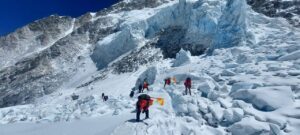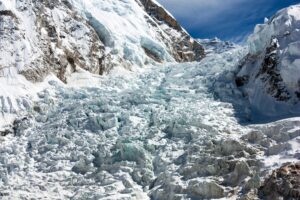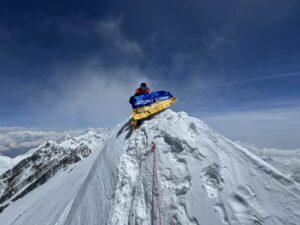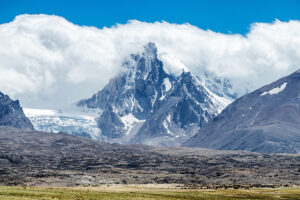Every May, 50 helicopters a day buzz over Everest Base Camp. The noisy machines have become a vital part of the 8,000m climbing industry, but at what cost?
Trekking up the Khumbu Valley, especially from Dingboche beyond the pine and rhododendron forests into the desert of rock and ice, takes your breath away — and not just because of the altitude. Sterling views of Ama Dablam, Kangtega, Thamserku, and Tawoche stand as silent witnesses to…oh wait, what’s that noise?
Helicopters commuting back and forth to the 8,000m Base Camps –- and spoiling the wilderness experience for many trekkers — have become constant during peak season in Nepal. According to Lukas Furtenbach, about 50 helicopters land at Everest Base Camp each clear spring day. This year, Annapurna and Dhaulagiri are also seeing a significant increase in aerial traffic, as helicopters shuttle gear and supplies for numerous expeditions.
This is mainly an issue in Nepal, because of its flourishing industry shuttling tourists, climbers, and materials up and down the mountains. The situation is totally different in China and Pakistan. In China, helicopters are not allowed for private ventures. In Pakistan, only Askari Aviation does airlifts, with strict requirements and under a contract belonging to a conglomerate owned by Pakistan’s army.
Nepal is more of a free market. Undoubtedly, private helicopter companies have helped the tourism industry and increased options for both visitors and locals. But the proliferation may be getting out of hand.

A helicopter touches down at Everest Base Camp. Photo: Alpine Club of Himalaya
Last week, Antonios Sykaris reported that he was told to board a helicopter from the village of Dana instead of trekking three days to Annapurna Base Camp. “It’s included in the price, so just jump in and don’t argue,” he was told.
Earlier, Andorra’s Stefi Troguet said that she was determined to trek to Dhaulagiri Base Camp instead of flying with most of the other climbers. “The trekking is an essential part of the experience,” she said. “It is the moment when you see and interact not just with the mountain, but with the country.”
In both cases, the climbers are part of the Seven Summit Treks team. The company, the biggest expedition operator in Nepal, owns a helicopter company, which it uses extensively to carry goods, but also climbers and guides, often offering a lift at no extra expense.
“Yes, I will fly to Base Camp,” Carlos Soria confirmed about his upcoming Dhaulagiri expedition. “I am going to acclimatize up the Khumbu Valley, so I can use these three days on the mountain. Also, it is good to minimize the risks of trekking.”
Besides Soria, Troguet, and their teams, several other Dhaulagiri climbers are acclimatizing up the Khumbu, including Horia Colibasanu and Marius Gane. It brings them to a decent altitude (Everest Base Camp lies at 5,350m) while enjoying an easy trek and plenty of comfortable accommodations. By contrast, the trek to Dhaulagiri requires overnight camping and includes some tricky passages.
Most climbers and outfitters consulted by ExplorersWeb acknowledge the pros and cons of helicopters in Nepal’s Himalaya. Billi Bierling pointed out their key role in rescues but admitted that they do disturb the wildlife.

Helicopters maneuver in the limited space at Lukla airport. Photo: The Kathmandu Post
Lukas Furtenbach considers them essential for the modern expedition industry because of their role in shuttling equipment and supplies. “There are not so many yaks in the Khumbu to supply so many expeditions,” he says.
A short flight, he adds, costs about the same as several days of food, accommodation, and guides. “Even in terms of carbon footprint, the brand new helicopters are a less polluting option than the very old diesel trucks [that bring the gear] to where the yaks start carrying the loads,” says Furtenbach.
“Every operator uses helicopters in some form or fashion,” Ryan Waters from Mountain Professionals says. “Therein lies the debate: How much or for what purpose is too much or lessens the difficulty of climbing Everest?”
If a helicopter is already flying to a base camp, Mountain Professionals will ship fresh food from Kathmandu on it from time to time. Nearly all outfitters exploit these existing flights.
“As a group, we feel good knowing that the helos are there for emergencies, although our goal is to never have to use them,” says Waters.
Teams also fly from Base Camp back to Kathmandu after the expedition rather than trek out. In that case, other outfitters may use the deadhead to fly in supplies or personnel, a cost-saving over chartering both ways.
Beyond expeditions, several private helicopter companies in Nepal offer flightseeing rides for tourists staying in Kathmandu or Pokhara.

Helicopters operate in several Nepali valleys beside the Khumbu. Photo: Air Dynasty
Few Everest climbers fly into Base Camp, because the trekking days are essential for acclimatization. But in peak season, the Everest skies still buzz with machines.
The sight and sound of helicopters have also become more common in other Nepal valleys. In recent years, some climbers complete one summit, then fly to Base Camp at another peak, in order to take advantage of their acclimatization to do a second or even a third 8,000’er.
This has dramatically increased the number of 8,000m peaks bagged by some individuals and also enriched the operators’ businesses. At the same time, with this approach, the expedition aspect disappears, as physically fit but not necessarily skilled climbers just go up and down a previously fixed route. Although this is a legitimate sport, its merits as a mountaineering accomplishment decrease if participants spend no time working on the route. Greater numbers also impact the fragile mountain environment.
And yet, the greatest debate among the use of helicopters in high-altitude expeditions spins around two topics: One, insurance fraud, when climbers falsely claim to be sick in order to get a free airlift from Base Camp. Two, when helicopters shuttle climbers not just to base camp but above, in order to bring them closer to the summit.
We’ll consider both these issues tomorrow, in the second part of this story.






